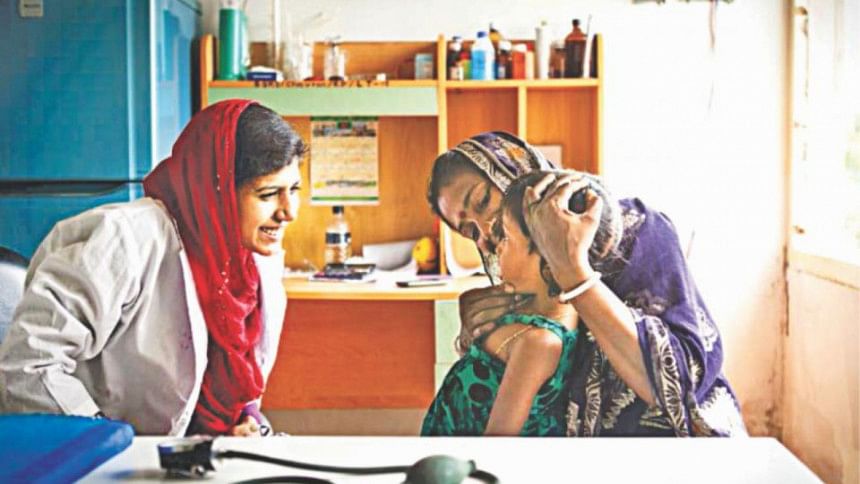Why computers get cheaper and health care doesn't

This is the subtitle of a book by William Baumol, an American economist who died recently at age 95. The title of the book is The Cost Disease. In his book, Baumol made several interesting arguments that have significant implications for public welfare in Bangladesh.
Since the rate of inflation is an average of the rates of growth of many different prices, there are some commodities whose prices are rising faster than the inflation rate, while prices of some goods are failing compared to the inflation rate. Baumol argued and demonstrated that items that generally belong to the rising-cost group are personal services such as health care and education; whereas items that belong to the falling-price group are manufactured goods such as computers, electronics, etc.
This is the idea of "cost disease," which Baumol and his co-authors originated in the early 1960s and was popularised in a book written by Baumol in 2012. The cost disease merely states that the cost of essential personal services rises at a significantly greater rate than the economy's rate of inflation.
The reason is simple. Items whose prices are increasing over time have a larger labour content than items whose prices are falling over time. For example, when we buy a health care service—for example, a visit to the doctor — it involves a lot of face-to-face interaction between us and the service provider (doctor, nurse, health clerks). In contrast, when we buy a computer, we do not have any idea who worked in the factory or how much labour time was spent to produce a computer.
It takes a lot of labour hours to make the first copy of a new medicine. However, after the first pill is created, additional copies can be produced very cheaply because of product standardisation. Put another way, because pills are identical, they can be manufactured on an assembly line by industrial robots. But the prescription of the medicine to a patient cannot be automated. A doctor must determine exactly what is wrong and tailor the treatment to the needs of the individual patient. This is why, generally, the cost of health care services rises because they involve a large handicraft component, while the cost of manufactured products (including medicines) tend to fall over time because their production can be automated.
It is not easy to reduce the labour hours in most personal services because doing so would damage the quality of those services. For example, if we try to speed up the work of a doctor, a teacher, or a policeman, we are likely to get shoddy heart surgery, poorly trained students, and more criminals on the streets. We are still very far from using artificial intelligence (something like IBM's Watson) that is capable of correctly diagnosing our illness and prescribing medicines. We can replace a teacher with a filmed lecture by an extraordinarily talented teacher, but we will miss asking questions. And the idea of using robotic police is something we are not willing to tolerate yet.
So, it is puzzling and interesting at the same time as to why labour-saving innovations for the very activities (e.g., health care, education, lawyers, restaurants, police protection) that are most critical for society's welfare are difficult to come by. Much of this is because it is tough to use fewer labours to produce these personal services. And wages tend to rise over time. For example, a musician playing a Beethoven string quartet today earns a much higher income (inflation-adjusted) than Beethoven did, even though one may argue that today's musicians are no more productive than their predecessors.
Where does Bangladesh stand on cost disease? Based on the consumer price index (CPI) data published on Bangladesh Bank's website, over the past twenty years (1995–2017), overall inflation grew at roughly 4.5 percent each year. Whereas, inflation rates for two personal services (where the share of labour input is relatively high) rose by 3.75 percent for medical care and health expenses, and by 2.8 percent for recreation, entertainment, education and cultural services. So we see that our overall inflation outpaced the growth of prices of personal services, suggesting that there is no "cost disease" in Bangladesh.
There are at least three explanations for this finding. First, wages of those involved with medical professions and colleges and universities are increasing slower than the overall inflation, keeping their prices low. Second, doctors and teachers are producing more output per hour, suggesting either productivity improvements or quality deterioration. Third, official data may be flawed, suppressing prices. For example, it is not clear why the inflation in the recreation, entertainment, education and cultural services category fell by over 25 percent in 2012-13.
The official CPI and its components published by the Bureau of Bangladesh Statistics still leave a rump of services within medical care and education categories that are more prone to the price increase. Rising costs are not problematic if income rises even faster. The real problem is the unavailability of price indexes of many personal services (think about a price index for medicines or tuition fees) that precludes us from drawing precise inferences about consumer inflation. Unfortunately, these ideas are rarely heard in our political discussions. The government should pay more attention to collecting detailed data on consumer inflation.
Syed Basher is an associate professor of economics at East West University. His work can be viewed at www.syedbasher.org





Comments